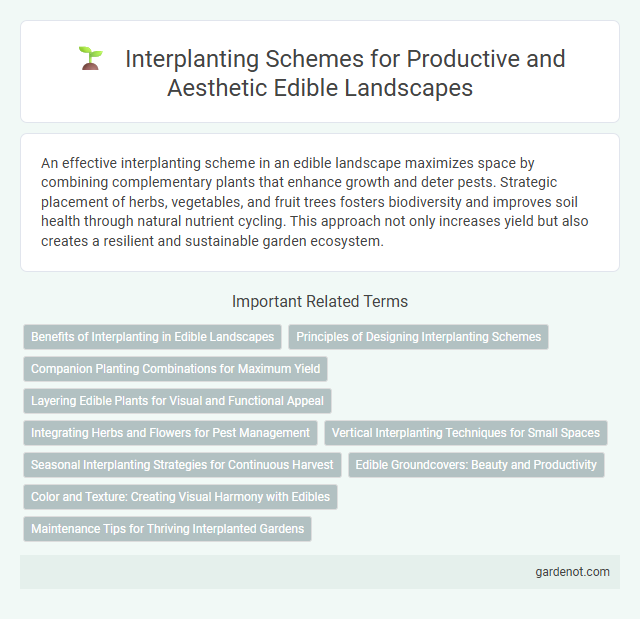An effective interplanting scheme in an edible landscape maximizes space by combining complementary plants that enhance growth and deter pests. Strategic placement of herbs, vegetables, and fruit trees fosters biodiversity and improves soil health through natural nutrient cycling. This approach not only increases yield but also creates a resilient and sustainable garden ecosystem.
Benefits of Interplanting in Edible Landscapes
Interplanting in edible landscapes enhances biodiversity by combining complementary plants that improve soil health and reduce pest infestations naturally. This technique maximizes space efficiency, allowing for higher yields on smaller plots while promoting nutrient sharing between species. Intercropping diverse crops also supports pollinators and beneficial insects, contributing to a resilient and sustainable garden ecosystem.
Principles of Designing Interplanting Schemes
Designing effective interplanting schemes in edible landscapes relies on principles such as complementary plant selection, spatial arrangement, and growth timing synchronization. Selecting species with compatible root depths and nutrient needs reduces competition while promoting mutual benefits like pest deterrence and improved pollination. Integrating vertical and horizontal layering maximizes space use, enhances biodiversity, and sustains soil health, fostering a resilient and productive landscape.
Companion Planting Combinations for Maximum Yield
Interplanting edible landscapes with companion planting combinations enhances nutrient uptake, pest control, and pollination, leading to maximum yield. Pairing basil with tomatoes repels harmful insects while improving flavor, whereas beans fix nitrogen, benefiting leafy greens such as spinach and Swiss chard. Strategic spacing and plant diversity optimize sunlight exposure and soil health, resulting in a robust, productive garden ecosystem.
Layering Edible Plants for Visual and Functional Appeal
Interplanting edible plants using a layering scheme maximizes space efficiency and enhances garden aesthetics by combining ground covers, mid-height vegetables, and tall fruiting trees. This method promotes biodiversity, improves soil health, and creates microclimates that support plant growth while producing a continuous harvest. Integrating herbs, berries, and leafy greens in strategic layers encourages natural pest control and pollinator activity essential for sustainable edible landscapes.
Integrating Herbs and Flowers for Pest Management
Interplanting schemes that integrate herbs and flowers, such as marigolds, basil, and nasturtiums, create a natural pest management system by attracting beneficial insects and repelling harmful pests. Herbs like rosemary and thyme release aromatic compounds that deter aphids and whiteflies, reducing the need for chemical pesticides. Combining these plants in edible landscapes enhances biodiversity, supports pollinators, and promotes healthier crop yields through sustainable pest control.
Vertical Interplanting Techniques for Small Spaces
Vertical interplanting techniques maximize space efficiency by integrating climbing vegetables, herbs, and fruiting vines on trellises or vertical supports, boosting yield in small edible landscapes. Utilizing vertical structures like arbors, fences, or wall-mounted planters allows growers to layer crops, such as beans over lettuce or strawberries alongside spinach, enhancing biodiversity and microclimate benefits. This method increases sunlight exposure, improves air circulation, and reduces soil-borne diseases, making it ideal for urban gardens, balconies, and compact backyard plots.
Seasonal Interplanting Strategies for Continuous Harvest
Seasonal interplanting strategies maximize edible landscape yield by combining fast-growing crops like radishes with slower-maturing plants such as tomatoes, ensuring continuous harvest throughout changing seasons. Incorporating legumes between leafy greens enhances soil nitrogen while providing fresh produce during transitional periods. Staggered planting dates and diverse plant selection optimize space and improve resilience against pests and weather fluctuations.
Edible Groundcovers: Beauty and Productivity
Edible groundcovers such as strawberries, creeping thyme, and clover maximize garden space while enhancing soil health and suppressing weeds. Strategic interplanting with taller crops improves light distribution and biodiversity, boosting overall garden productivity. Integrating diverse edible groundcovers creates a resilient ecosystem that combines beauty with functional yield in edible landscapes.
Color and Texture: Creating Visual Harmony with Edibles
Interplanting schemes in edible landscapes combine diverse colors and textures to enhance visual harmony and garden productivity. Using contrasting foliage like deep purple kale alongside bright green lettuce adds dynamic appeal, while textured herbs such as curly parsley interspersed with smooth-leaved basil create tactile interest. This strategic mix not only beautifies the space but also supports plant health and yield through complementary spacing.
Maintenance Tips for Thriving Interplanted Gardens
Regular monitoring of soil moisture and nutrient levels ensures optimal growth in interplanted edible landscapes. Pruning overcrowded plants improves air circulation, reducing disease risk and promoting healthy development. Implementing mulch layers conserves moisture and suppresses weeds, minimizing maintenance efforts while supporting diverse plant health.
Interplanting scheme Infographic

 gardenot.com
gardenot.com